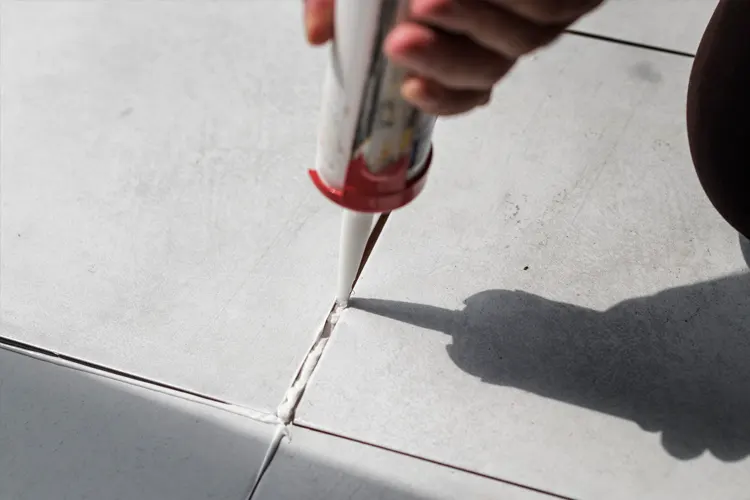Concrete surfaces, whether driveways, sidewalks, patios, or foundations, naturally develop cracks over time due to weather changes, ground movement, and regular wear and tear. Without proper sealing, these cracks can allow water infiltration, leading to further deterioration, mold growth, and costly structural issues. That’s where caulk for concrete comes into play.
Caulking for concrete helps:
- Prevent water damage by sealing out moisture.
- Enhance durability by preventing further cracking and shifting.
- Improve appearance by creating a seamless, smooth surface.
- Reduce maintenance costs by extending the lifespan of concrete surfaces.
What is Self-Leveling Concrete Caulk?
Self-leveling concrete caulk is a specialized sealant designed to fill cracks and joints in horizontal concrete surfaces. Unlike traditional caulks, it spreads evenly without the need for smoothing or tooling, making it an ideal solution for a clean and professional finish.
Benefits of Self-Leveling Caulk for Concrete
- Easy application – Flows into cracks and levels itself without manual smoothing.
- Flexible and durable – Expands and contracts with temperature changes.
- Water and weather-resistant – Protects against rain, snow, and UV exposure.
- Ideal for driveways, sidewalks, and patios – Works well for large and small cracks alike.
How to Apply Self-Leveling Concrete Caulk
Using self-leveling caulk for concrete is a simple process that requires minimal tools and effort. Here’s a step-by-step guide to get the job done effectively:
Step 1: Clean the Surface
Remove any dirt, debris, or old caulk from the crack or joint using a wire brush or pressure washer. Allow the area to dry completely before applying new caulk.
Step 2: Prepare the Caulk
Cut the tip of the self-leveling concrete caulk tube at an angle and load it into a caulking gun. For deep cracks, use a backer rod to fill the bottom before applying caulk to ensure a proper seal.
Step 3: Apply the Caulk
Slowly squeeze the caulking gun and apply the sealant evenly along the crack. Let the caulk flow and level itself naturally—avoid excessive smoothing.
Step 4: Allow Proper Curing Time
Check the manufacturer’s recommendations for drying time. Most self-leveling caulk for concrete sets within a few hours and fully cures within 24-48 hours.
Why Caulking for Concrete is Essential
Concrete surfaces, whether driveways, sidewalks, patios, or foundations, naturally develop cracks over time due to weather changes, ground movement, and regular wear and tear. Without proper sealing, these cracks can allow water infiltration, leading to further deterioration, mold growth, and costly structural issues. That’s where caulk for concrete comes into play.
Caulking for concrete helps:
- Prevent water damage by sealing out moisture.
- Enhance durability by preventing further cracking and shifting.
- Improve appearance by creating a seamless, smooth surface.
- Reduce maintenance costs by extending the lifespan of concrete surfaces.
What is Self-Leveling Concrete Caulk?
Self-leveling concrete caulk is a specialized sealant designed to fill cracks and joints in horizontal concrete surfaces. Unlike traditional caulks, it spreads evenly without the need for smoothing or tooling, making it an ideal solution for a clean and professional finish.
Benefits of Self-Leveling Caulk for Concrete
- Easy application – Flows into cracks and levels itself without manual smoothing.
- Flexible and durable – Expands and contracts with temperature changes.
- Water and weather-resistant – Protects against rain, snow, and UV exposure.
- Ideal for driveways, sidewalks, and patios – Works well for large and small cracks alike.
How to Apply Self-Leveling Concrete Caulk
Using self-leveling caulk for concrete is a simple process that requires minimal tools and effort. Here’s a step-by-step guide to get the job done effectively:
Step 1: Clean the Surface
Remove any dirt, debris, or old caulk from the crack or joint using a wire brush or pressure washer. Allow the area to dry completely before applying new caulk.
Step 2: Prepare the Caulk
Cut the tip of the self-leveling concrete caulk tube at an angle and load it into a caulking gun. For deep cracks, use a backer rod to fill the bottom before applying caulk to ensure a proper seal.
Step 3: Apply the Caulk
Slowly squeeze the caulking gun and apply the sealant evenly along the crack. Let the caulk flow and level itself naturally—avoid excessive smoothing.
Step 4: Allow Proper Curing Time
Check the manufacturer’s recommendations for drying time. Most self-leveling caulk for concrete sets within a few hours and fully cures within 24-48 hours.
Choosing the Best Caulk for Concrete
When selecting caulking for concrete, consider the following factors:
1. Silicone-Based vs. Polyurethane Caulk
- Polyurethane caulk offers superior adhesion and flexibility, making it ideal for areas that experience frequent movement, such as driveways and expansion joints.
- Silicone-based caulk provides excellent water resistance and is best suited for areas exposed to excessive moisture, such as pool decks and foundations.
- Polyurethane is paintable, whereas silicone typically is not, which can be a deciding factor if color matching is important.
2. UV and Weather Resistance
- If your concrete surfaces are exposed to direct sunlight, rain, or extreme weather, select a caulk specifically designed for UV resistance and weatherproofing.
- Look for high-performance polyurethane or advanced hybrid sealants that maintain flexibility in hot and cold temperatures without cracking or peeling.
3. Paintability
- Some caulks can be painted over once dried, allowing for seamless blending with concrete surfaces.
- Silicone caulks are generally non-paintable, so if you need to match a specific color, opt for a polyurethane or acrylic latex caulk instead.
4. Brand Reputation and Quality
- Stick to well-known brands with proven durability and positive reviews, such as Sikaflex, DAP, and Loctite.
- These brands offer a range of caulking products that cater to different applications, from general crack sealing to heavy-duty expansion joint sealing.
- Always read product specifications and choose one that aligns with your project needs.
Properly sealing cracks and joints with self-leveling caulk for concrete is essential for maintaining durable, long-lasting concrete surfaces. By following the right techniques and choosing high-quality caulk, you can prevent costly repairs and keep your concrete structures looking and performing their best.
If you need professional assistance with concrete repair, contact The Mudjacking Contractor for expert solutions!
Final Thoughts
Properly sealing cracks and joints with self-leveling caulk for concrete is essential for maintaining durable, long-lasting concrete surfaces. By following the right techniques and choosing high-quality caulk, you can prevent costly repairs and keep your concrete structures looking and performing their best.

